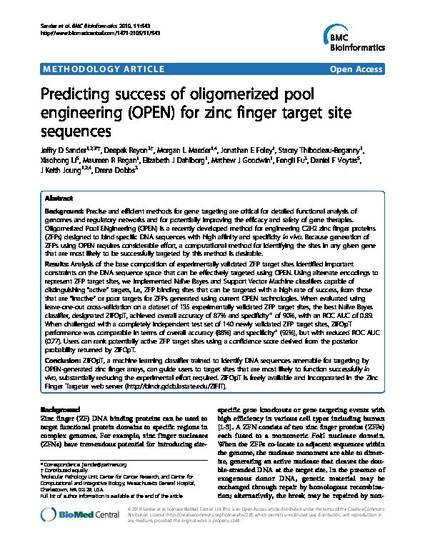
Background: Precise and efficient methods for gene targeting are critical for detailed functional analysis of genomes and regulatory networks and for potentially improving the efficacy and safety of gene therapies. Oligomerized Pool ENgineering (OPEN) is a recently developed method for engineering C2H2 zinc finger proteins (ZFPs) designed to bind specific DNA sequences with high affinity and specificity in vivo. Because generation of ZFPs using OPEN requires considerable effort, a computational method for identifying the sites in any given gene that are most likely to be successfully targeted by this method is desirable.
Results: Analysis of the base composition of experimentally validated ZFP target sites identified important constraints on the DNA sequence space that can be effectively targeted using OPEN. Using alternate encodings to represent ZFP target sites, we implemented Naïve Bayes and Support Vector Machine classifiers capable of distinguishing “active” targets, i.e., ZFP binding sites that can be targeted with a high rate of success, from those that are “inactive” or poor targets for ZFPs generated using current OPEN technologies. When evaluated using leave-one-out cross-validation on a dataset of 135 experimentally validated ZFP target sites, the best Naïve Bayes classifier, designated ZiFOpT, achieved overall accuracy of 87% and specificity+ of 90%, with an ROC AUC of 0.89. When challenged with a completely independent test set of 140 newly validated ZFP target sites, ZiFOpT performance was comparable in terms of overall accuracy (88%) and specificity+ (92%), but with reduced ROC AUC (0.77). Users can rank potentially active ZFP target sites using a confidence score derived from the posterior probability returned by ZiFOpT.
Conclusion: ZiFOpT, a machine learning classifier trained to identify DNA sequences amenable for targeting by OPEN-generated zinc finger arrays, can guide users to target sites that are most likely to function successfully in vivo, substantially reducing the experimental effort required. ZiFOpT is freely available and incorporated in the Zinc Finger Targeter web server (http://bindr.gdcb.iastate.edu/ZiFiT).
Available at: http://works.bepress.com/drena-dobbs/12/

This article is from BMC Bioinformatics 11 (2010): 543, doi: 10.1186/1471-2105-11-543. Posted with permission.